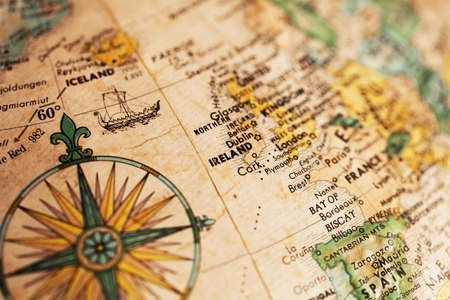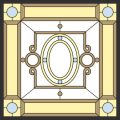Introduction to the Bagua Map in Feng Shui
Feng Shui is an ancient Chinese practice that focuses on creating harmony between people and their environments. At the heart of Feng Shui is the Bagua Map—a powerful tool used to analyze and balance different areas of a home. But what exactly is the Bagua Map, and how can it be relevant for homes in the United States?
What Is the Bagua Map?
The Bagua Map is a grid divided into nine sections, each representing a key aspect of life such as wealth, health, relationships, and career. “Bagua” means “eight areas” in Chinese, with a ninth area at the center symbolizing overall well-being. In Feng Shui, each section (also called a “gua”) is connected to specific colors, elements, shapes, and life goals.
The Origins and Principles
The concept of the Bagua comes from traditional Taoist philosophy. For centuries, it has been used to guide the arrangement of living spaces so that positive energy—known as “chi”—can flow smoothly throughout the home. The map is usually placed over a floor plan to help identify which parts of your house correspond to different aspects of your life.
Why Does the Bagua Map Matter for American Homes?
While Feng Shui began in China, its principles are adaptable for modern American lifestyles. Whether you live in a suburban ranch house, a city apartment, or a classic colonial home, using the Bagua Map can help you create spaces that support your goals and enhance your daily experience. By aligning your floor plan with these ancient guidelines, you can bring more balance and intention into your home environment.
Bagua Areas and Their Life Aspects
| Bagua Area | Life Aspect | Main Color/Element |
|---|---|---|
| Wealth & Prosperity | Finances & Abundance | Purple / Wood |
| Fame & Reputation | Recognition & Social Life | Red / Fire |
| Love & Relationships | Romance & Partnerships | Pink / Earth |
| Family & Health | Family Harmony & Well-Being | Green / Wood |
| Center (Health) | Overall Balance & Vitality | Yellow / Earth |
| Children & Creativity | Kreativity & Future Projects | White / Metal |
| Knowledge & Self-Cultivation | Learning & Growth | Blue / Earth |
| Career & Life Path | Work & Life Journey | Black / Water |
| Helpful People & Travel | Support Network & Opportunities | Gray / Metal |
No matter what kind of home you live in across the United States—from New York brownstones to California bungalows—the Bagua Map offers a flexible way to bring mindful design into your space. Understanding its origins and basic principles is the first step toward applying this powerful tool to any American floor plan.
2. Understanding Floor Plans in the United States
Before you can successfully apply the Bagua Map to your home, it’s important to understand the typical floor plans you’ll find in American houses and apartments. U.S. homes come in many shapes and sizes, but there are a few common layouts that you’re likely to encounter. Knowing these will help you figure out how to align the Bagua Map with your space for the best results.
Common American Floor Plan Layouts
| Layout Type | Description | Bagua Application Tips |
|---|---|---|
| Open Concept | Large living areas with few or no walls between kitchen, dining, and living rooms. | Use rugs, furniture arrangement, or lighting to visually separate Bagua areas since walls are minimal. |
| Ranch-Style | Single-story layout with all main rooms on one floor, often long and rectangular. | The Bagua Map usually fits easily over this type; align it with the main front entrance for best results. |
| Split-Level | Multiple levels separated by short sets of stairs; often has half-floors or sunken areas. | Treat each level as its own “mini” Bagua or use the main entrance level as the primary map reference point. |
| Traditional Two-Story | Main living spaces downstairs, bedrooms upstairs; clear separation between public and private areas. | Apply the Bagua Map separately to each floor—focus on shared family spaces downstairs and personal energy upstairs. |
| Apartment/Condo | Compact spaces, often rectangular or square, sometimes with irregular corners. | Align the Bagua with your front door wall; use mirrors or plants to activate missing corners if needed. |
How to Identify Your Floor Plan Type
If you’re not sure which category your home falls into, look at your layout from above (like a blueprint). Think about where your main entrance is and how rooms flow from one area to another. This will help you choose the right approach for applying Feng Shui principles using the Bagua Map.
Quick Reference: American Home Features That Affect Feng Shui Application
- Main Entrance Location: In many U.S. homes, the front door opens into a foyer or directly into the living room. This is considered your entry point for the Bagua Map.
- Open vs. Closed Spaces: Open concepts require creative zoning; traditional layouts allow for more precise mapping.
- Irregular Shapes: If your floor plan has missing sections or extensions (like bay windows), note these as they may represent missing or enhanced Bagua areas.
- Multi-Level Living: Each story can be mapped individually for more tailored Feng Shui adjustments.
Tip:
No matter what type of floor plan you have, always start by drawing your layout on paper. Mark where your main door is—this is key for aligning the Bagua Map in any American home setting!
![]()
3. Aligning the Bagua Map with Your Floor Plan
When it comes to applying Feng Shui in American homes, aligning the Bagua Map correctly is essential for tapping into positive energy and creating balance. There are two popular methods used in the United States: the Front Door Method and the Compass Method. Below, youll find a simple guide on how to use both approaches, no matter if you live in a ranch-style home, townhouse, or apartment.
Front Door Method
This is the most common method in the U.S. because its straightforward and doesnt require a compass. Here’s how you do it:
- Print or draw a Bagua Map divided into nine equal sections.
- Stand at your main entrance (the front door you use most often).
- Place the bottom of the Bagua Map so it lines up with your front wall—the wall with your main door.
- Lay the map over your entire floor plan, stretching it from wall to wall.
| Bagua Area | Location from Front Door (Left to Right) |
|---|---|
| Knowledge & Self-Cultivation | Bottom Left |
| Career & Life Path | Bottom Center (at entry) |
| Helpful People & Travel | Bottom Right |
| Family & Health | Middle Left |
| Center (Health) | Middle Center |
| Creativity & Children | Middle Right |
| Wealth & Prosperity | Top Left |
| Fame & Reputation | Top Center |
| Love & Relationships | Top Right |
Tips for Irregular Floor Plans
- If your home isn’t a perfect square or rectangle, imagine a grid that covers your entire space—including garages or extensions—even if part of it falls outside your actual walls.
- If you have multiple stories, align the Bagua for each floor using its own main entrance.
Compass Method
The Compass Method brings more precision by using magnetic directions. Here’s how to try it out:
- Stand in the center of your home with a compass or compass app.
- Mark where North is on your floor plan.
- Lining up North on your Bagua Map with North on your home’s plan, overlay the map so each sector matches its corresponding direction.
| Bagua Area | Main Direction (Compass) |
|---|---|
| Career & Life Path | North |
| Knowledge & Self-Cultivation | Northeast |
| Family & Health | East |
| Wealth & Prosperity | Southeast |
| Fame & Reputation | South |
| Love & Relationships | Southwest |
| Creativity & Children | West |
| Helpful People & Travel | Northwest |
| Center (Health) | The center of your home/floor plan |
Selecting Which Method to Use in Your U.S. Home:
- If you want a simple start and have an obvious main entryway, go with the Front Door Method.
- If you enjoy detail and accuracy—or if your home’s layout is unique—try the Compass Method.
- You can also experiment with both methods to see which feels best for you and your family’s lifestyle!
The key is consistency: once you choose a method, stick with it throughout your home to keep energy flowing smoothly from room to room.
4. Bagua Areas: Adapting Energy Zones for American Living Spaces
The Bagua map divides your home into nine energy zones, each representing an important aspect of life. Understanding how these areas relate to typical American rooms makes applying Feng Shui practical and fun. Below is a simple overview of the nine Bagua areas with examples of where they might be found in a standard American house or apartment.
| Bagua Area | Meaning | Common American Room Example |
|---|---|---|
| Wealth & Prosperity (Xun) | Financial abundance, prosperity, and self-worth | Home office, corner of living room, or a dedicated workspace |
| Fame & Reputation (Li) | Recognition, reputation, and how you are seen by others | Family room mantel, media center, or prominent wall for diplomas/photos |
| Love & Relationships (Kun) | Romantic relationships and partnerships | Main bedroom or master suite |
| Family & Health (Zhen) | Family harmony and physical health | Dining room or family gathering space |
| Center (Tai Qi) | Overall balance and wellness | The middle of the home—often a hallway or open space connecting rooms |
| Children & Creativity (Dui) | Children, creativity, and future projects | Kid’s playroom, craft area, or guest room |
| Knowledge & Self-Cultivation (Gen) | Learning and personal growth | Study nook, reading corner, or home library shelf |
| Career & Life Path (Kan) | Your career journey and life purpose | Main entryway or foyer; can also be a dedicated work zone in an open layout |
| Helpful People & Travel (Qian) | Mentors, friends, networking, and travel opportunities | Mudroom, front closet, or guest entrance area; could also be a vision board spot for travel dreams |
How to Find Each Bagua Area in Your Floor Plan
The simplest way to apply the Bagua map in an American home is to align the bottom edge of the map with your main entrance wall. Then divide your floor plan into nine equal sections from that perspective. Each section will correspond to one of the above energy zones.
Easy Examples for Different Room Types:
- A traditional suburban home: The Wealth area might land in a quiet study at the back left corner; the Career zone could be right at the front door.
- A city apartment: The Relationship zone may coincide with one end of your studio layout—add pairs of items here to enhance love energy.
- An open-plan loft: Use rugs, lighting, or furniture groupings to subtly define different Bagua areas within the larger space.
Quick Tips for Enhancing Each Zone:
- Add vibrant plants or a money bowl in the Wealth area.
- Display awards or inspiring art in the Fame section.
- Create a cozy couple’s retreat in the Relationship zone—even if it’s just a comfy loveseat.
This approach lets you tap into Feng Shui benefits while honoring your unique American lifestyle and floor plan.
5. Practical Tips for Enhancing Each Bagua Area
Applying the Bagua map to your American home isn’t just about placement—it’s also about making each section feel vibrant and balanced. Here are practical, culturally-appropriate tips and décor ideas to boost positive energy in every Bagua area, no matter your floor plan.
Bagua Areas and Easy Enhancement Ideas
| Bagua Area | Main Life Aspect | Suggested Décor & Actions |
|---|---|---|
| Wealth & Prosperity (Southeast) | Abundance, Financial Growth | Add a healthy plant or small fountain, display family heirlooms, use green or purple accents, hang inspiring artwork or quotes about success. |
| Fame & Reputation (South) | Recognition, Reputation | Use bright lighting, red décor, diplomas or awards; display meaningful trophies or certificates on shelves. |
| Love & Relationships (Southwest) | Romance, Partnerships | Add pairs of objects (candlesticks, pillows), soft textures, pink or earth-tone colors; hang photos of you with loved ones. |
| Family & Health (East) | Family Harmony, Well-being | Display family photos, add wood furniture or green plants; choose calming greens and blues for décor. |
| Center | Overall Balance, Health | Keep this area clutter-free; use earthy tones and square shapes; place a bowl of fruit or a low-maintenance plant as a centerpiece. |
| Children & Creativity (West) | Keepsake Projects, Creativity | Create an art wall with kids’ drawings, use white or pastel colors; include fun, creative tools like sketchpads or games. |
| Knowledge & Self-Cultivation (Northeast) | Personal Growth, Study | Add a bookshelf with favorite books; create a cozy reading nook with blue accessories; hang inspirational posters. |
| Career & Life Path (North) | Work Success, Career Goals | Add a water element like an aquarium or picture of flowing water; use black and dark blue tones; keep the entryway tidy and inviting. |
| Helpful People & Travel (Northwest) | Mentors, Networking, Travel Plans | Display travel souvenirs; use metal frames for photos of friends or mentors; add globes or travel maps as décor. |
Culturally-Appropriate Feng Shui Tips for U.S. Homes
- Select Local Art: Choose artwork that resonates with your personal story—landscapes of places you love in the U.S., family portraits, or inspirational quotes in English.
- Add Comfort: Use cozy throws and pillows in living spaces to create warmth and relaxation—an important value in many American homes.
- Personalize Décor: Incorporate items from your travels within the U.S., sports memorabilia, or holiday decorations for authenticity.
- Avoid Clutter: Americans often value open space—ensure walkways are clear and surfaces aren’t overcrowded.
Troubleshooting Common Floor Plan Challenges
- If Your Home Is Open-Concept: Use rugs or furniture placement to define Bagua areas without building walls.
- If You Have Missing Corners: Place mirrors on interior walls to symbolically “complete” missing Bagua sections.
- If Doors Are Misaligned: Hang wind chimes near doors to slow down rushing energy.
Your Next Steps: Try Small Changes First!
You don’t need a total makeover to see results. Start by enhancing one Bagua area that feels important right now. Even adding a new plant or rearranging furniture can make a noticeable difference in how your space feels!


